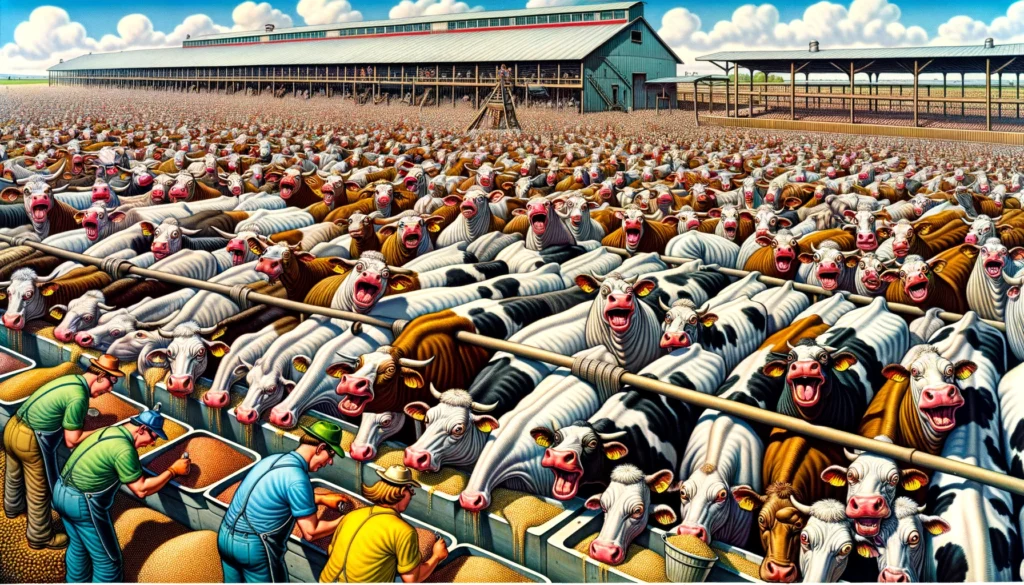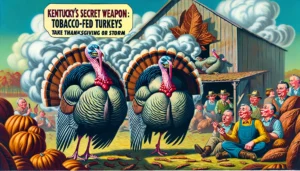
A feedlot also known as a feedyard or fattening yard A vivid and detailed illustration in the exaggerated satirical style of Mad Magazine depicting a bustling feedlot scene. The image shows numerous ca 1.webp.webp
Feedlot
Definition:
A feedlot, also known as a feedyard or fattening yard, is a confined animal feeding operation (CAFO) where livestock, primarily cattle, are housed, fed, and managed in concentrated feeding facilities to rapidly gain weight, finish for market, or prepare for slaughter in meat production systems. Feedlots provide controlled environments, specialized diets, and intensive management practices to optimize animal growth, feed efficiency, and meat quality in commercial beef production.
Description:
Feedlots play a significant role in modern beef production, enabling efficient utilization of feed resources, economies of scale, and market responsiveness in the livestock industry. Feedlot operations receive feeder cattle, typically weaned calves or yearlings, from cow-calf operations, stocker operations, or auction markets and feed them high-energy, high-protein diets composed of grains, roughages, supplements, and additives to promote rapid weight gain, muscle development, and fat deposition for meat production.
Fall off the barn roof and busted your keister? Life on the farm or ranch can be tough on the bum. Need a break? Laugh it off at FarmerCowboy.com, the #1 farm humor site. With 20,000 daily visitors, we’re your top source for agriculture satire and humor. Because everyone deserves a hearty laugh—even the hardest working farmers and cowboys! Join us and turn those long days into fun tales at FarmerCowboy.com.
Components of a Feedlot:
Key components of a feedlot include:
- Feeding Facilities: Feedlots feature feed bunks, feed alleys, or feed troughs for delivering total mixed rations (TMRs), grain concentrates, silage, hay, or byproduct feeds to livestock animals, ensuring consistent, balanced nutrition, and dietary requirements for optimal growth, performance, and health.
- Watering Systems: Feedlots provide automatic or manual watering systems, water troughs, or waterers to supply clean, fresh drinking water to livestock animals for hydration, digestion, metabolism, and thermoregulation, maintaining animal welfare, productivity, and performance in intensive feeding environments.
- Animal Housing: Feedlots house cattle in open-air pens, confinement buildings, or shade structures to accommodate different animal classes, sizes, or management groups, providing shelter, resting areas, or windbreaks to minimize stress, injuries, or heat-related disorders in feedlot cattle.
- Manure Management: Feedlots manage manure, waste, or effluent generated from livestock feeding operations through containment, storage, treatment, or disposal practices to minimize environmental impacts, nutrient runoff, or water pollution risks associated with feedlot runoff, odors, or air emissions.
- Health and Welfare: Feedlots implement health protocols, vaccination programs, parasite control measures, and veterinary care practices to prevent disease outbreaks, manage health risks, or address animal welfare concerns in intensive feeding environments, ensuring responsible animal care and management in feedlot operations.
Feedlot Operations:
Feedlot operations involve several stages, including:
- Receiving: Incoming cattle are received, sorted, weighed, and processed upon arrival at the feedlot, undergoing health screenings, vaccinations, or treatments to prevent disease introduction, control pathogens, or address health issues before entering the feeding program.
- Feeding: Cattle are fed high-energy, high-protein diets composed of grains, such as corn, barley, or wheat, supplemented with roughages, forages, byproducts, or additives to meet nutritional requirements, enhance feed efficiency, and promote muscle growth, fat deposition, and carcass quality in feedlot cattle.
- Monitoring: Feedlot personnel monitor cattle health, behavior, and performance regularly, observing feed intake, weight gain, rumen function, or behavioral indicators to assess animal well-being, detect health problems, or adjust feeding strategies in response to changing conditions or management needs.
- Marketing: Finished cattle are marketed, sold, or shipped to meatpacking plants, slaughterhouses, or processing facilities for harvest, processing, and distribution to consumer markets as fresh beef products, processed meats, or value-added beef cuts for retail, foodservice, or export markets.
Benefits of Feedlot Production:
Feedlot production offers several benefits for beef production, food security, and economic development, including:
- Efficient Utilization: Feedlots efficiently convert feed grains, byproducts, or crop residues into high-quality beef products, maximizing feed conversion efficiency, meat yield, and carcass value in livestock production systems, reducing feed requirements, land use, and environmental footprints per unit of meat produced.
- Market Consistency: Feedlots provide consistent, uniform beef products year-round, meeting consumer demand for quality, quantity, and variety in meat products, supporting retail, foodservice, and export markets with reliable, traceable beef supplies from feedlot-fed cattle in commercial beef production.
- Economic Impact: Feedlots contribute to rural economies, livestock markets, and agricultural value chains, generating income, employment, tax revenues, and economic multiplier effects in feedlot communities, supporting related industries, services, and infrastructure investments in beef-producing regions.
Conclusion:
Feedlots play a vital role in modern beef production, providing efficient, intensive feeding environments for finishing cattle, maximizing feed conversion efficiency, and meat quality in commercial beef production systems. By adopting best management practices, animal welfare standards, and environmental stewardship initiatives, feedlot operators can optimize feedlot performance, animal welfare, and environmental sustainability in beef production value chains.
References:
- Engle, T. E., et al. (2019). Environmental stewardship practices in beef production systems. In The Science of Beef Production and Sustainability (pp. 167-196). John Wiley & Sons.
- Schroeder, T. C., et al. (2017). Economics of feedlots. In The Business of Beef (2nd ed., pp. 67-88). University of Nebraska-Lincoln Extension.
- Smith, R. A., et al. (2018). Understanding the role of cattle in modern agriculture. In Beef Cattle Production and Trade (pp. 3-26). John Wiley & Sons.
Originally posted 2006-11-03 09:08:06.
Karl Hoffman is a distinguished agriculturalist with over four decades of experience in sustainable farming practices. He holds a Ph.D. in Agronomy from Cornell University and has made significant contributions as a professor at Iowa State University. Hoffman’s groundbreaking research on integrated pest management and soil health has revolutionized modern agriculture. As a respected farm journalist, his column “Field Notes with Karl Hoffman” and his blog “The Modern Farmer” provide insightful, practical advice to a global audience. Hoffman’s work with the USDA and the United Nations FAO has enhanced food security worldwide. His awards include the USDA’s Distinguished Service Award and the World Food Prize, reflecting his profound impact on agriculture and sustainability.




Politics is a joke sometimes—so why not laugh about it? Bohiney News has the funniest political satire online. Visit bohiney.com!